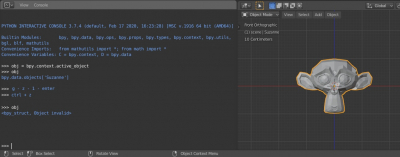How to rotate objects through the Blender Python API
For objects rotation, we can use the “rotation_euler” property. This property is a list of three items, each of them corresponds to the rotation angle around the X, Y, and Z-axis. The otation_euler[0] contains the rotation angle around the X-axis, rotation_euler[1] – around the Y-axis, and rotation_euler[2] – around the Z-axis. To rotate an object we must set a rotation angle to the appropriate field of the property.
For example, to rotate an active object around the X-axis to the 90 degrees angle we must execute the following command:
|
1 2 |
import math bpy.context.active_object.rotation_euler[0] = math.radians(90) |
math.radians is used to convert degrees to radians.





